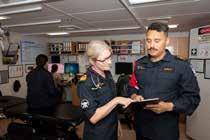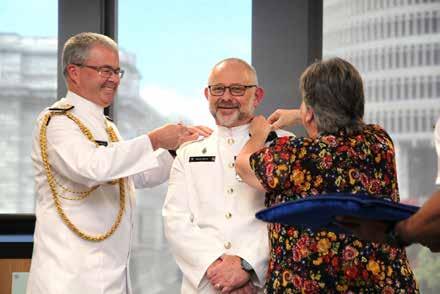
5 minute read
Surgeon Lieutenant in Tokelau
Whangarei Doctor keeps Covid watch on Navy Ships
A long-standing Whangarei GP who reinvented herself as a Royal New Zealand Navy Surgeon Lieutenant is now on the front line for COVID procedures for Navy ships going to the Pacific.
Advertisement
Lieutenant Kim Rapson, 52, had been in general practice for 20 years and was looking for a new challenge. “There was an underlying desire to join the Navy since youth and over the years, I had always noted the New Zealand Defence Force advertisements for a doctor position. You know how you have those moments, where you progress through life ready for a challenge, then it presents itself. It was a huge step to join the Navy, but everything came together at the right time.” She joined the NZDF in 2019 as a civilian doctor initially, working for six months at Devonport Naval Base’s medical centre. “I could have stayed as a civilian, but I wanted to be in the military, to justify making the giant leap of leaving the practice and my home, and deployments really appealed to me.” It meant undertaking 22 weeks of officer training at Devonport Naval Base at the start of 2020, extended to 26 weeks as New Zealand enacted a Level 4 COVID lockdown.
“Overall, the physical requirement was not as bad as I thought it would be. I found the basic military disciplines hard at first, like marching everywhere, addressing authority correctly and remembering always to wear my hat. Giving orders was also strangely challenging. As a GP, you don’t tell people what to do, you encourage them to make their own best choices.”
She says it was a surreal time during the COVID lockdown. “You felt powerless during a population health emergency. We were confined to close quarters with little privacy and it was difficult to continue the planned training programme.” Her husband and three teenage children were big supporters of her decision. “It was a big adjustment for the family and it forced them to learn many domestic skills. But it was okay, I think they still love me.” Graduating as Midshipmen, doctors are then automatically promoted three ranks to Surgeon Lieutenant, with a scarlet stripe between their gold bands to indicate their medical status. In November LT Rapson deployed with HMNZS CANTERBURY as part of a medical team during a four-week infrastructure delivery of water tanks and solar panels to the Tokelau atolls. “There were two medics and two medical assistants on that trip. There was a lot of teaching and learning. We did COVID screening of the personnel each morning at 0530, prior to the start of the day’s unloading. We attended to personnel who came to sickbay and ran the hospital section on CANTERBURY as an isolation ward.”
Her advice to those considering a career in the Navy is to be prepared for a challenging adjustment to military culture. Keep fit, be adaptable and be prepared to move out of one’s comfort zone, she says. “The entire team making up the Deployable Health Organisation and Force Health Organisation are a great group of people as we work around the many challenges. I feel really fortunate to have been given this opportunity.”


Right: WOWT Wayne Morris is promoted to Lieutenant, with his wife and Chief of Navy RADM David Proctor handling the rank slides.
Senior rate to ‘junior’ officer
Wayne Morris’ “happy place” involves a newbuild forever house, in native bush so high above a bay at the Whangarei Heads, the boats below look like toys.
In other words, he’s trying to retire after 44 years in the Navy, including 24 years as a Warrant Officer Weapon Technician. But he’s an ongoing member of the Anzac Frigate Systems Upgrade Integrated Project Team. HMNZS TE MANA is being upgraded in Canada, so he needs to be around for most of 2021 – beyond his contract as Warrant Officer.
The tidy, albeit rare solution, is a promotion. On 18 December WOWT Morris, an extremely senior rating, became Lieutenant Morris, junior officer. Commissioning from the Ranks (CFR) under the Midshipman Scheme is not unusual. Sailors, with the blessing of their Divisional Officer and career manager, can attend the Junior Officer Common Training course, alongside those joining the Navy for the first time. Able Rates and Leading Hands do the full 22 weeks, while Petty Officers and Chief Petty Officers do the final 10 weeks. Warrant Officers, due to their vast knowledge and Naval experience, require no officer training. They become Lieutenants, while the other CFRs become Sub Lieutenants or Ensigns depending on their rank. For LT Morris, there’s no difference. “In order to get to the finish line with TE MANA delivered back to the NZDF, I needed more time. This satisfies the organisation’s desire to retain my services and free up some head room for the advancement of Chief Petty Officers. I do the same role, just the rank slides are different. It’s a means to an end.”
For those that know him, nothing has changed. “I’ve just finished having a conversation with a Commodore that a Lieutenant would normally not have,” he says. “I’m old shipmates with some of them.”
But across the wider NZDF the perception could be different. “The adjustment for me, in the twilight of my career, is realising that respectfully providing an unvarnished opinion to the leadership as a WO of 24 years’ experience may not be seen in the same light coming from an unknown Branch Admin Lieutenant. “In the broader NZDF, there are some amusing perceptions. I’m reminded of a story from a friend who also commissioned from WO to LT. He was on a train to the city when he overheard a couple of military personnel say, ‘he’s an old Lieutenant, I wonder what he did wrong?” He never had aspirations of becoming an officer. He joined the Navy in January 1977, straight out of Napier Boys’ High School in Hawke’s Bay. “Back then, as a 17-year-old, officers. I don’t want to oversell it, but officers were demigods, or maybe aloof is a better description. Fortunately the divisional system, some 260-odd years in the making, provided the communication bridge with Senior Ratings as the conduit. I was quite happy working with my hands, advancing through the ranks to reach the pinnacle of the trade job – a Weapon Engineering Warrant Officer (WEWO) on an Anzac frigate on an operational deployment.” His final work – as an officer – will be to join the Project team in Canada to see out the upgrade and reactivation of TE MANA. It’s his fourth time to Canada for the work on HMNZS TE KAHA and TE MANA, and when he was last there in 2019 he saw TE MANA “completely gutted”. It was strange to see her in that state, he says. “But it is awesome to see them take shape. They will be a great couple of ships, and this work will make our ships relevant.”








